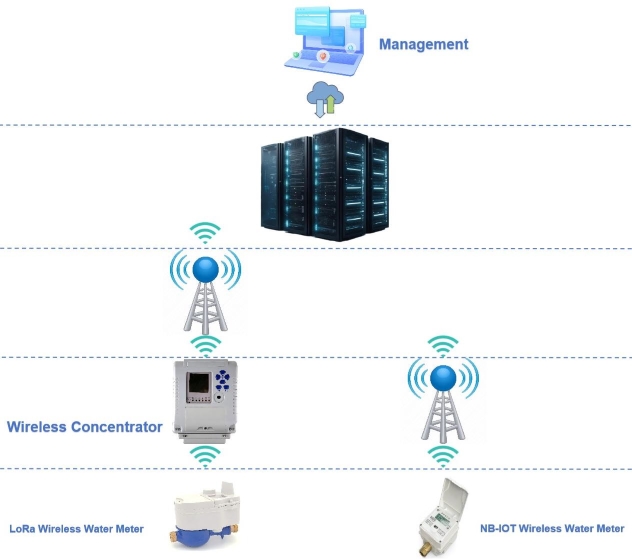Introduction
With the advancement of technology and the rapid development of information systems, water utility companies now require more than just timely fee collection. The demand has shifted towards digital transformation, automated data acquisition, networked data analysis, and scientific decision-making. Smart water meters must not only support prepaid functionality but also enable remote automatic/semi-automatic data collection.
By integrating multiple communication technologies, smart meters can establish two-way remote communication with the prepaid information management system, facilitating automatic data acquisition. This eliminates the reliance on external recharge media such as CIU, infrared keyboards, and RFID cards. The AMR/AMI prepaid solution ensures efficient and intelligent water metering, helping utilities improve operational efficiency, reduce costs, and enhance service quality.

Application Scenarios
Urban and Suburban Areas: ideal for deployment in both high-density urban environments and suburban regions, enabling efficient meter management and data collection
Remote and Hard-to-Reach Areas: the long-range communication capability of smart metering solutions makes them suitable for installations in locations with limited power supply or network infrastructure
Large-Scale Meter Deployments: designed for water utilities managing thousands of meters across vast areas, ensuring seamless automation and real-time data acquisition
Underground and Indoor Installations: the deep penetration capability of advanced communication technologies ensures reliable data transmission even in underground or indoor environments
Smart City Integration: seamlessly integrates with urban IoT ecosystems, supporting large-scale, low-power, and automated meter reading applications
Component
Smart Water Meter: equipped with prepaid functionality and capable of real-time data transmission via integrated communication technology
Data Collection Devices: includes mobile data collectors (MDCs) for semi-automatic data collection and data concentrator units (DCUs) for fully automated data aggregation
Prepaid Management System: a central platform for data analysis, billing, recharge processing, and operational monitoring
Cloud-Based Platform: stores and processes meter data, enabling remote monitoring, reporting, and analytics.
User Interface: mobile applications or web-based platforms for balance inquiry, recharge, and consumption monitoring.
Work Process
Prepaid Recharge: users make payments through an online platform, mobile application, or indoor display unit, and the meter balance updates automatically
Automated/Semi-Automated Data Collection: utility staff can use mobile data collectors for walk-by meter reading, or meters can transmit data directly to data concentrators or central systems
Real-Time Data Transmission: smart meters periodically send consumption data and operational status to the management system
Remote Monitoring and Control: the central system analyzes data, detects anomalies, and generates reports for billing, leakage detection, and consumption trends
Advantages
Long-range Communication: ensures reliable data collection over large distances, reducing the need for additional infrastructure
Energy Efficiency: low-power consumption extends battery life, minimizing maintenance costs
Flexible Deployment: supports both manual (walk-by) and automated data collection, optimizing operational efficiency
Real-Time Data Monitoring: enables instant data retrieval, leak detection, and remote system management.
Cost-Effective Solution: utilizes existing communication networks, reducing installation and maintenance costs
Scalability: easily integrates into smart city frameworks, supporting large-scale deployments with minimal power consumption

 | Phone:+86 (0)25-86618785 Whatsapp:+86 18115602654 |
 | Factory 1 Address:No. 576, Huoju South Road, Huancui District, Weihai City, Shandong Province, China Factory 2 Address:Changde Water Meter Smart Technology Industrial Park, No. 9 Gangzhong West Road, Changde, Hunan Province |